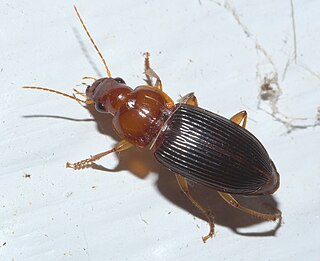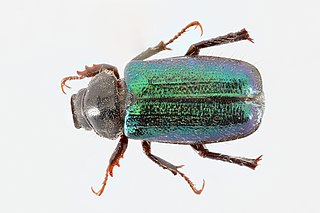
John Lawrence LeConte was an American entomologist, responsible for naming and describing approximately half of the insect taxa known in the United States during his lifetime, including some 5,000 species of beetles. He was recognized as the foremost authority on North American beetles during his career, and has been described as "the father of American beetle study".

Agathidium is a genus of beetles in the family Leiodidae.

The Boridae are a small family of tenebrionoid beetles with no vernacular common name, though recent authors have coined the name conifer bark beetles. The family contains three genera. Boros is native to North America and northern Eurasia, Lecontia is endemic to North America, while Synercticus is found in Australia and New Guinea. The larvae of Boros are found under bark and are especially associated with standing dead trees (snags), typically pines, found in old-growth forests. Lecontia larvae are found inhabiting damp parts of the root system of dead standing trees. Little is known of the life habits of Synercticus.

Cortodera is a genus of beetles in the family Cerambycidae, containing the following species:

Lepturinae, the lepturine beetles, is a subfamily of the longhorn beetle family (Cerambycidae), containing about 150 genera worldwide. This lineage is most diverse in the Northern Hemisphere. Until recently the subfamily Necydalinae was included within the lepturines, but this has been recently recognized as a separate subfamily. Nine tribes are usually recognized today, with a tenth, Caraphiini, created in 2016. A few genera are of uncertain placement within the subfamily.

Centrodera is the genus of the Lepturinae subfamily in long-horned beetle family. Beetles of this genus are distributed in North America, most of them are found only in United States.
Brachysomida californica is a species of long-horned beetle in the subfamily Lepturinae from western North America. It was described by John Lawrence LeConte in 1851 from the Santa Cruz Mountains in California.
Brachysomida bivittata is the species of the Lepturinae subfamily in longhorn beetle family. The beetle is distributed in Canada, and Nebraska, United States.

Melanophila is a genus of buprestid beetles commonly known as fire beetles. They have extraordinary sensitivity to infrared radiation (heat), using a specialized sensor organ near their legs.

Brachysomida is a genus of beetles in the family Cerambycidae, containing the following species:

Stenocorus is a genus of beetles in the family Cerambycidae, containing the following species:

Trachyderini is a tribe of long-horned beetles in the family Cerambycidae. There are at least 140 genera and 650 described species in Trachyderini.

Harpalini is a tribe of a diverse group of ground beetles belonging to the subfamily Harpalinae within the broader family Carabidae. The tribe contains more than 1,900 species.
Optioservus is a genus of riffle beetles in the family Elmidae. There are about 13 described species in Optioservus.

Dichelonyx is a genus of May beetles and junebugs in the family Scarabaeidae. There are at least 30 described species in Dichelonyx.

Chaetarthria is a genus of water scavenger beetles in the family Hydrophilidae. There are more than 20 described species in Chaetarthria.

Silis is a genus of soldier beetles in the family Cantharidae, found mostly in Europe and the Americas. There are at least 80 described species in Silis.

Metaclisa is a genus of darkling beetles in the family Tenebrionidae, the sole genus of the tribe Metaclisini. There are at least four described species in Metaclisa, found in North America, the Neotropics, the Palearctic, and Indomalaya.















